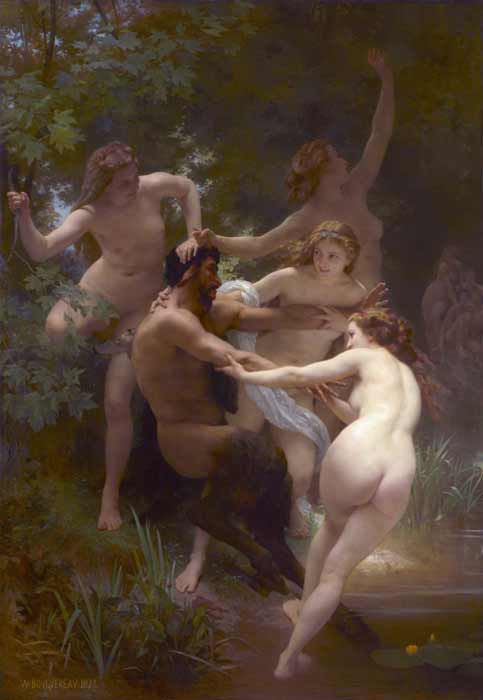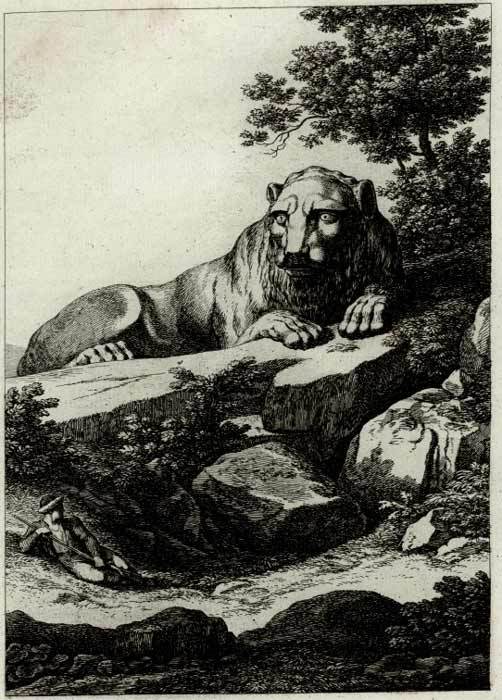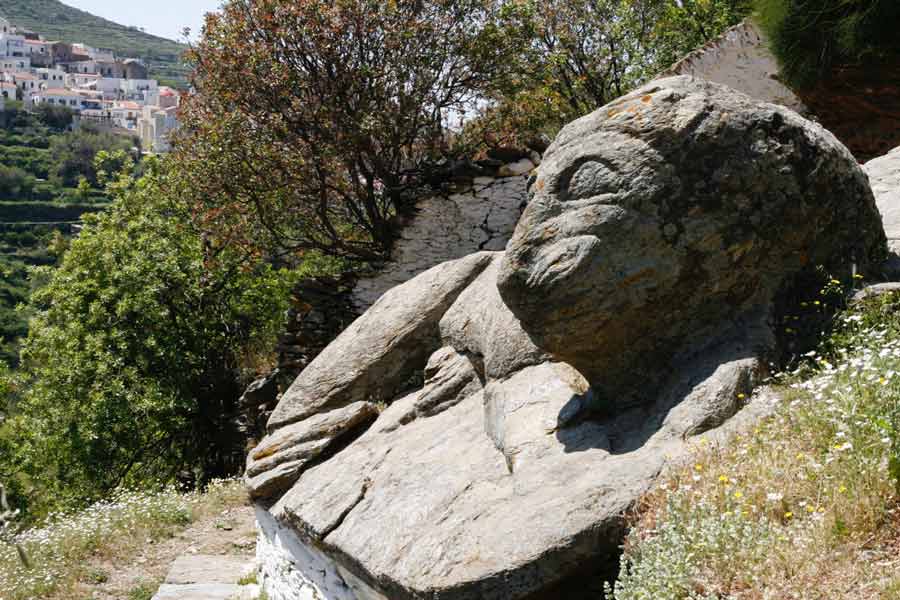The Protector of Kea Island: The Lion of Kea
The Greek island of Kea has been a popular location since ancient times, given that it is the closest Cycladic Island to Athens. One of the most famous monuments of the island is the Lion of Kea, an early Greek monument created around 600 BC. The lion, known as liontas to locals, has been a sire of wonder for years. Although little is known about the sturdy stone statue, local myths are told about its creation and its iconic Archaic smile.

The myths surrounding the Lion of Kea, on the Greek island of the same name, are intertwined with stories of water nymphs said to have provoked the gods. (Public domain)
The Lion of Kea and Related Myths
Numerous myths try to explain the lion’s creation. The starting point for most of these tales is that Kea island was home to water nymphs who used their beauty to make the gods jealous. Thanks to this behavior, the gods sent a lion to lie in wait and protect the island from the provocative nymphs. While the true reason for the creation of the lion monument is unknown, almost all the related myths claim that the island was once home to water nymphs.
In John Caskey’s 1981 article, Notes on Keos and Tzia, he detailed the lion and its importance in maintaining the island’s fertility and clean drinking water. The island itself is said to have had many freshwater springs from which the nymphs would drink. The gods sent the lion to the island to chase the nymphs away and keep the island's water safe. According to Caskey, the sculpture serves as “a poetical record of a rare and damaging drought, still symbolized by a huge figure of the beast on a hillside near Ioulis.”
- Exquisite 12th Century Lion Sculpture Dragged From Reservoir in Cambodia
- The Piraeus Lion of Venice: Runes and Roaming from Greece to Italy
In another myth, it is said that Kea Island was once known as the Water Island due to its many natural springs and nymphs. The myth claims that the gods were jealous of the island’s natural beauty, and in their wrath sent a lion to destroy it. When the nymphs were scared away by the islands new inhabitant, the island lost its water source and lost its beauty. After Kea's people asked the god Aristaeus for help to salvage their island, Zeus was pleased and allowed for rain and for the water nymphs to return. This created the beautiful island that visitors see today.

In 1826 the Danish writer Peter Oluf Brödsted drew the Lion of Kea in great detail. (Public domain)
What Do We Know About the History of the Lion of Kea?
The Lion of Kea is located outside the ancient city of Ioulida, with some of the original ruins still visible. Created before 600 BC, the lion was carved from natural stone measuring 8 meters (26 ft) long and 3 meters (9.8 ft) tall. The creator of this mysterious sculpture is unknown, though archaeologists have concluded that it is made of local limestone.
The isolated space around the sculpture could be a grave marker, taking into account that it was standard for statues of lions to signify burials and there are multiple lion sculptures around prominent graves across Greece. If the Lion of Kea were to be a grave marker, it would be one of the elders' funerary monuments. On the other hand, there are alternative theories which claim that the Lion of Kea was a marker for nearby freshwater streams.
Writers and explorers have been visiting the island to see the Lion of Kea for hundreds of years. In 1826, Danish writer Peter Oluf Brödsted drew the lion in great detail. Similarly, in 1885 James Theodore Brent visited the island and wrote about the legends he had heard surrounding the creation of the monument. Brent also wrote a detailed description of the Lion:
“It is impossible to fix a date or assign a cause for the construction of the Keote lion; one thing is certain, that it is of very archaic work, more so that the lions at the gate of Mycene."
The island of Kea has been inhabited for centuries, beginning in the Bronze Age. Its close proximity to Athens and the rest of mainland Greece was ideal. The island is full of steep mountains, olive groves, and Hellenistic towers. Four ancient cities, Ioulis, Korissia, Pisses, and Karthaia, have been built on Kea, all important cites to the Ancient Greeks. There are still ruins around the island, giving visitors a glimpse of life in the ancient cities that once thrived on Kea.

The Lion of Kea can be found near to Ioulida, the capital of the Greek island of Kea. (costas1962 / Adobe Stock)
Archaic Greek Sculpture and the Lion of Kea
Many historians believe that the Lion of Kea is one of the oldest and most significant works of Greek monumental sculptures discovered to date. Chiseled out of one singular block of local limestone, it showcases the ability of the sculptor back in the 6th century BC. While there may be a lack of information about its creation, the sculpture itself fits into the category of Archaic sculpture and shares similarities with others found around Greece from the same era. The statues in Naxos, for example, are similar in size and craftsmanship. The Terrace of Lions - sixteen stone lions dedicated to the god Apollo - exemplify the significance of lions to the Greeks.
- Unravelling the Tragic Story Behind the Impressive Lion Monument of Lucerne
- The Seductive Sirens of Greek Mythology: How the Heroes Resisted Temptation
Lions have been used as a sign of strength and protection for thousands of years. “Ready to challenge the city’s enemies and roaring their defiance at any who dare approach with hostile intent,” wrote the historian Trevor Bryce when discussing their importance. The Lion of Kea was carved with the characteristic Archaic smile, common in sculptures from the 5 th and 6 th century BC.
It is believed that the popularity of smiles was due to it being a sign of ideal health and well-being. Another theory behind the smile was the difficulty of carving stone; creating a curved mouth was much easier to achieve. Although the Lion of Kea does appear to have an Archaic smile, some archaeologists believe that smile has been caused by thousands of years of natural erosion, which would mean that the lion’s original expression is no longer visible today.
The body of the Lion of Kea also relates to Archaic styles, with the modeling of the lion’s tail curving around the body. It was typical of Archaic sculptures to depict an intense curvature of a lions’ body, and these curves can still be noted even after centuries of erosion. Many archaeologists believe that the lion was originally colored when first created, especially the head and the eyes. While the specific history of the Lion of Kea remains unknown, the wonder and mystery surrounding it have brought attention to Kea Island for generations, attracting travelers and tourists to gaze at its ancient form and majesty.
Top image: The Greek statue of the Lion of Kea resides on the island of Kea in the Cyclades archipelago of the Aegean Sea. Source: Sebastian Schulz / Adobe Stock
By Sarah Piraino
References
Brent, J. T. 1885 [2002]. The Cyclades: Or, Life Among the Insular Greeks. 3rdguides.
Brouwers, J. 2012. “Lions in Ancient Greece” in Ancient World Magazine. Available at: https://www.ancientworldmagazine.com/articles/lions-ancient-greece/
Bryce, T. 2004. Life and Society in the Hittite World. Oxford University Press.
Caskey, J. L. 1981. Notes on Keos and Tzia. Hesperia. Volume 50, Issue 4, pp. 320 – 326. Available at: https://www.jstor.org/stable/147875
Encyclopedia Britannica Editor. No date. “Archaic Smile” in Britannica. Available at: https://www.britannica.com/art/Archaic-smile
Lloyd, M. 2020. “The Lion of Kea” in Ancient World Magazine. Available at:https://www.ancientworldmagazine.com/articles/lion-kea-archaic-enigma/
No name. No date. “Kea Stone Lion” in greeka. Available at: https://www.greeka.com/cyclades/kea/sightseeing/kea-stone-lion-of-loulis/
No name. No date. “Kea - Chora (Ioulis) and Vicinity - The Lion of Ioulis” in Greece Off the Beaten Track. Available at: https://www.zeus.guide/kea-travel-guide/e-kea-chora-ioulis-and-vicinity-the-lion-of-ioulis/



















